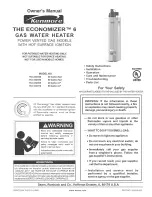
9
WFB
English
Safety instructions
Important:
Keep this manual with the unit throughout its entire service life;
Carefully read this manual before carrying out any operation on
the unit;
Y
Do not exceed the design limits given on the dataplate.
!
The safety devices on the compressed air circuit must be pro-
vided for by the user.
Before starting any maintenance operations, make sure that the
circuits are not under pressure.
Only use the unit for professional work and for its intended pur-
pose.
The user is responsible for analysing the application aspects for
product installation, and following all the applicable industrial
and safety standards and regulations contained in the product
instruction manual or other documentation supplied with the unit.
Tampering or replacement of any parts by unauthorised personnel
and/or improper machine use exonerate the manufacturer from
all responsibility and invalidate the warranty.
The manufacturer declines and present or future liability for dam-
age to persons, things and the machine, due to negligence of the
operators, non---compliance with all the instructions given in this
manual, and non---application of current regulations regarding
safety of the system.
The manufacturer declines any liability for damage due to alter-
ations and/or changes to the packing.
It is the responsibility of the user to ensure that the specifications
provided for the selection of the unit or components and/or
options are fully comprehensive for the correct or foreseeable use
of the machine itself or its components.
When requesting technical assistance or ordering spare parts, al-
ways quote the model and serial number on the identification pla-
te mounted externally on the unit.
IMPORTANT:
The manufacturer reserves the right to modify this
manual at any time.
For the most comprehensive and updated information, the user is
advised to consult the manual supplied with the unit.
1 Introduction
Transport / Handling
S
Use lifting equipment of suitable capacity to lift and
move the unit (fork lift etc.).
S
Protect the unit from impact to prevent damage to in-
ternal components.
S
The manufacturer assumes no liability for damages
which may be caused by decayed or modified packa-
ging.
Inspection
As soon as you receive the unit, check its condition;
if you
notice any damage inform the carrier immediately.
2 Assembly
(see Fig. 1)
N.B.:
For flanged models, if the optional counterflanges/
gaskets kit has not been acquired these must be supplied
by the user.
j) Fix the gasket (4) to the refrigerant gas outlet (1) then
couple it to the separator (horizontally), as described
in the separator manual (*) Fig. 1 shows the position
of the separator.
k) Attach gasket (8) and counterflange (5) to the
separator’s outlet using the bolts (7).
Make sure that the flanges are parallel before tightening
the flange bolts.
Do not exceed the recommended tightening torque set-
tings given in Fig. 1.
2.1 --- Aftercooler without separator
a) Attach gasket (2) and counterflange (3) to the after-
cooler’s (1) air inlet using the bolts (6).
b) Attach gasket (4) and counterflange (5) to the after-
cooler’s (1) air outlet using the bolts (7).
3 Installation
(see. Fig. 2)
a)
Respect the operating limits given on the dataplate.
These limits must be observed in all cases.
The unit is designed for treating biogas or gas mixtu-
res containing traces of corrosive substances; in parti-
cular, it is advisable not to exceed the following limits:
H2S=400ppm;
HCI=10ppm;
HF=10ppm.
b) Support the unit on suitable mountings.
c)
The unit must be protected (gas side) by one or more
safety valves to ensure that the design pressure is not
exceeded.
These valves must be fitted in such a way that there is
no risk of any expelled fluid coming into contact with
operators.
d) If the pressurised fluid circuit is subject to vibration,
use flexible hoses and vibration dampers to connect up
the unit, or secure the circuit more firmly to eliminate
the vibrations.
If the circuit is subject to pressure pulses of more than
10% rated pressure, install a pulse damper to reduce
them to below this level.
The number of cycles at nominal pressure 0 must be
less than 1000 over the lifetime of the machine.
e) Make sure that the air around the unit does not con-
tain contaminating solids or gases.
Take particular care with sulphur, ammonia, chlorine
and installations in marine environments. For further
advice or assistance consult the manufacturer.
f) Arrange suitable supports for the gas inlet and outlet
pipes in case they dangerously stress the correspon-
ding outlets and/or connection flanges.
g) If the unit is installed in a seismic zone, install suitable
devices to protect against seismic activity.
h) Install fire---prevention and fire---fighting equipment
suitable for the area in which the unit is installed in or-
der to protect it against fire.
i) If operating temperature exceeds 60
˚
C, fit any protec-
tive guards necessary to prevent accidental contact and
burns.
RESPECT THE DIRECTION OF THE GAS/WATER
INLET AND OUTLET PLATES.
GAS CONNECTIONS: Fix the piping of the fluid to be
treated to the flanged connections on the refrigerant (if
the counterflange kit supplied by the manufacturer is not
used, make sure the inside diameter allows the fluid to
flow freely through all the refrigerant pipes). The systems
must be installed immediately downstream of the blower,
and with the separator downstream of the refrigerant.











































